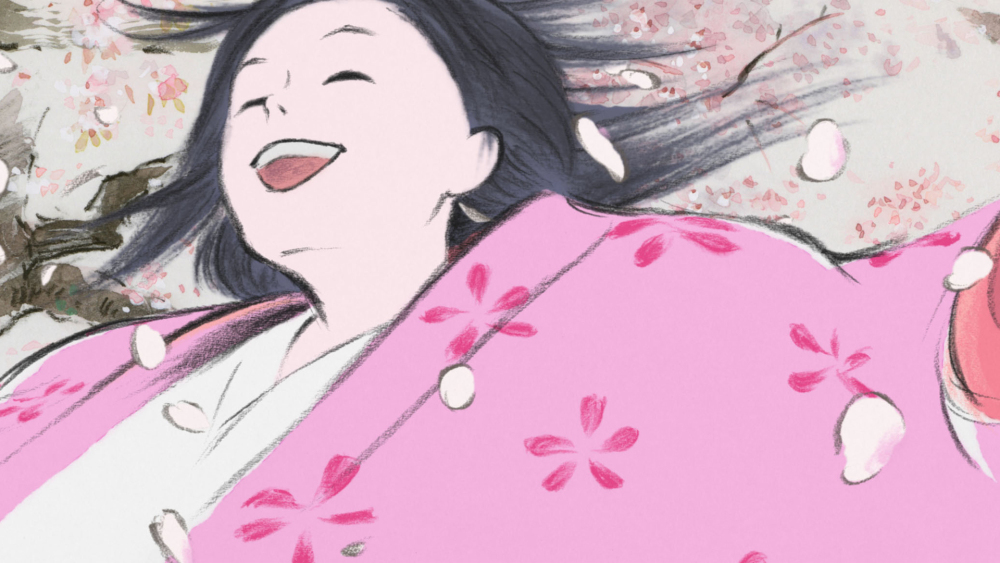
Earlier this year, the venerable Studio Ghibli announced that it was going on production hiatus after the next slate of films they had coming down the pike. Two of those last three films are presumed to be the final features by studio cofounders Hayao Miyazaki and Isao Takahata. It’s interesting that for their respective swan songs, Miyazaki and Takahata perform what amount to impressions of each other. In Miyazaki’s The Wind Rises, events grounded in everyday reality are augmented by dreamlike asides and flourishes, while Takahata’s The Tale of the Princess Kaguya operates in full-on fable mode. But neither of these films are mere auteurist pastiches: Miyazaki’s WWII biopic was his most emotionally and politically complex film, while Takahata’s watercolour fairy tale is just and as achingly beautiful and tragic as anything else in his filmography.
The film is a retelling of the Tale of the Bamboo Cutter, a 10th-century Japanese folk story. A poor bamboo cutter (voiced by the late Takeo Chii, best known for his work on Lady Snowblood) discovers a pea-sized princess at the root of a luminescent bamboo tree. Once home, the princess turns into what appears to be a regular human baby girl, albeit one who ages exponentially quickly up to the age of twelve. Over time, the bamboo cutter keeps finding valuables at the bases of trees: gold nuggets, silken fabrics, the whole nine. This convinces him that his daughter is destined to for regal greatness. The girl, nicknamed Lil’ Bamboo, would rather just fart around with her friends. Nevertheless, against the daughter’s wishes, the family moves from their humble country home to a palace in the city, where Lil’ Bamboo begins her rocky transformation into the titular princess.
Folk tales like this can end up being about a million different things, but there’s a pretty consistent line traversing The Tale of the Princess Kaguya about finding out what really makes you happy and focusing on that, lest you be overcome with regret afterwards. It can also easily be about how people can smother your happiness despite their best intentions. A lot of stuff about male entitlement and the effect it has on women is present, too. Those last two are incredibly important: the main crux of the dramatic tension in the film is between the bamboo cutter’s ambitions for his own daughter and her own inability to push back against it in a general way. So she responds in two ways: full dedication and full sabotage. If she’s going to do this, it’ll be on her own terms, even if she doesn’t want to do in in the first place. Emotionally complex stuff for what is essentially a children’s film.
But the major selling point here is the art style. Takahata builds upon the digital watercolours of My Neighbors the Yamadas, this time around adding charcoal, pencil, and wax crayon to the mix. Borders, backgrounds, and facial details aren’t always filled out, giving the whole film a hazy oniric quality. The overall effect is spellbinding; it’s like watching a master painter’s sketchbook come to life. The animation itself is even rendered in a textured way, as if every frame was hand-painted by a highly-skilled artisan. There’s a sequence where Kaguya runs away from a party, where her distress is literalized in the animation: everything becomes increasingly scratchy and abstract, like something out of Brakhage or McLaren. It’s an example of a traditional animated film taking advatage of the medium’s elasticity to create something jaw-dropping and vibrant.
When people talk about Studio Ghibli, the first name that comes to mind is usually Miyazaki. He co-founded the studio, most of his movies produced there are stone-cold classics and/or genre touchstones, and he is the de facto face of the organization. But while Miyazaki gets all the glory, it’s fellow studio cofounder Takahata who is Ghibli’s secret weapon (a title he shares with composer Joe Hisaishi). While Miyazaki is the better high-fabulist of the two, Takahata is the better kitchen-sink dramatist. Though he doesn’t have a stylistic/thematic stamp as pronounced as Miyazaki’s (which likely explains his relative sleeper status among anime neophytes), Takahata has proven to be a more malleable director. Though his output for the studio is much smaller than that of his better-known cohort (5 films to Miyazaki’s 9), it’s more eclectic and grounded, and often more emotionally devastating. This is, after all, the man responsible for Grave of the Fireflies, the anime weepie par excellence, known to reduce even the most stone-hearted viewer to a blubbering puddle of snot and tears. But if The Tale of the Princess Kaguya does prove to be Takahata’s final film, it will stand as one of the most visually arresting and emotionally charged sendoffs imaginable. Also, the whole film’s final sequence then acts as an even more poignant farewell to a director (and a studio) that consistently strove for excellence and very often achieved it.
—
The Tale of the Princess Kaguya is currently playing in limited release in the United States.
Directed by Isao Takahata; written by Riko Sakaguchi and Isao Takahata; starring Aki Asakura, Takeo Chii, Nobuko MIyamoto, Kengo Kora, and Atsuko Takahata; 137 minutes,



 Derek
Derek
 Isabelle
Isabelle